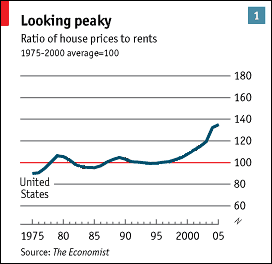
If lending standards did not get completely abused and you actually needed a 20% down payment and could only borrow up to 28% of your gross income, home prices would have been checked by income. Instead they came untethered. So much so that the NAR said forget the old first time affordability rules. We will just change the rules. Now you only need a 10% down payment and can use 40% of your gross income to buy that charming house in Chula Vista.
Well now the bubble seems to have popped. Remember the Business Week Map of Misery Chart. California is the epicenter for Option ARM loans.
But something curious is happening. Borrowers in mass are starting to make the minimum payment on their Option ARM loans. So much so that the lending institutions are seeing huge increases in capitalized interest because they are essentially lending their borrowers their mortgage payment (look at the SEC filings for DSL, GDW, FED,WM...). Concerned and late to the party, the Interagenices issue new guidance to rein in the exotic loans. Ouch, says Countrywide, "Requiring lenders to qualify borrowers on the true cost of a loan, the company said, 'would tend to defeat the intended function of the loan and would significantly reduce the number of borrowers that could qualify.'" Whoa.
The rise in short-term rates would normally have checked the real estate markets a couple of years earlier if not for the Stated Income Option Arm. Imagine if you had used an interest-only ARM that adjusts annually to purchase a home in late 2003 or early 2004. Assume that there is no minimum payment feature. Your first year rate could have easily been 3.5%, and because that was the "real" rate for the ARM, you may have been qualified at that rate. A year goes by and short-term rates move up dramatically such that your new payment might be at 4.25%. Ouch! That's a 21% increase in my mortgage payment. Another year goes by and rates go up again. Double Ouch! My mortgage rate has gone up to 5.5% and my payment has increased 57% from inception. I barely qualified when I bought this house. How am I going to be able to make my mortgage payment?
Now if you live in Colorado you just have a hard time of it. There are not as many Option Arm loans available in Colorado as compared to California. So what do you do? Hand the bank the keys. That's why Colorado is currently seeing higher levels of foreclosure activity.
But if you live in California, what do you do? Well, when your first reset hit on your original ARM, you called your mortgage guy. No problem he says. We will refinance your IO loan into an Option ARM and your payment (minimum) will actually go down even though interest rates have risen. This is akin to Jesus walking across San Diego Bay. It's a miracle!
Of course, the problem is you just delayed the inevitable and made the problem worse. Your minimum payment rate can only last so long. The "real" rate has been rising with the up tick in mortgages tied to short-term rates. You can run your balance up to maybe 110-125% of the original balance, but that's it. The house has stopped appreciating, and maybe is starting to decline in value so you can't refinance. So you and everyone else make the MINIMUM PAYMENT. This means you don't need to worry about foreclosure just yet. You might be able to do this for a few more months.
So the bank is now in the position of contractually loaning a marginal borrower more money to make his payments. In past times this borrower may have already went into default, but the minimum payment gives him a chance for a short period of time. It's significantly worse for the bank because the LTV is rising into the eventual foreclosure. And it is rising because the bank is actually lending a troubled borrower more money just before the borrower hands the bank the keys.
This is why Downey, FirstFed, Golden West, Wamu and other lenders are seeing huge increases in their capitalized interest to loan interest income ratios. This is why their balance sheets are seeing huge increases in the amount of negative amortization included in loan balances. I don't believe this has ever happened.
Are falling rates going to bail out all these borrowers? How could it given that money was given away for free. You could lie about your income. You could make payments that were not reflective of the true cost and this was in an interest rate environment that gave borrowers the lowest true rates in a generation.
As this becomes more evident it will certainly cause repercussions in the MBS market. It will cause problems for the portfolio lenders. It will cause problems for the hedge funds that bought sub-prime MBSs and leveraged them up to enhance the return. It will cause problems for foreign central banks including China.
Certainly, these were not your Father's mortgage backed securities.
2007 should be really interesting with another $1,000,000,000,000 in resets














